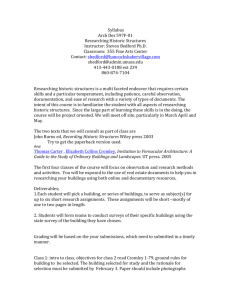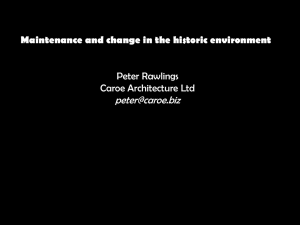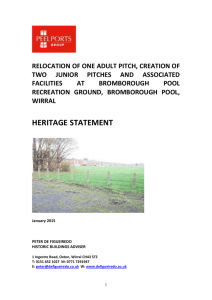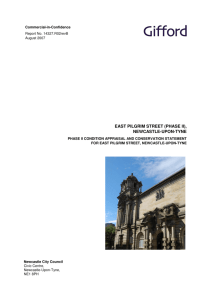Highlights of Conservation Management Plan
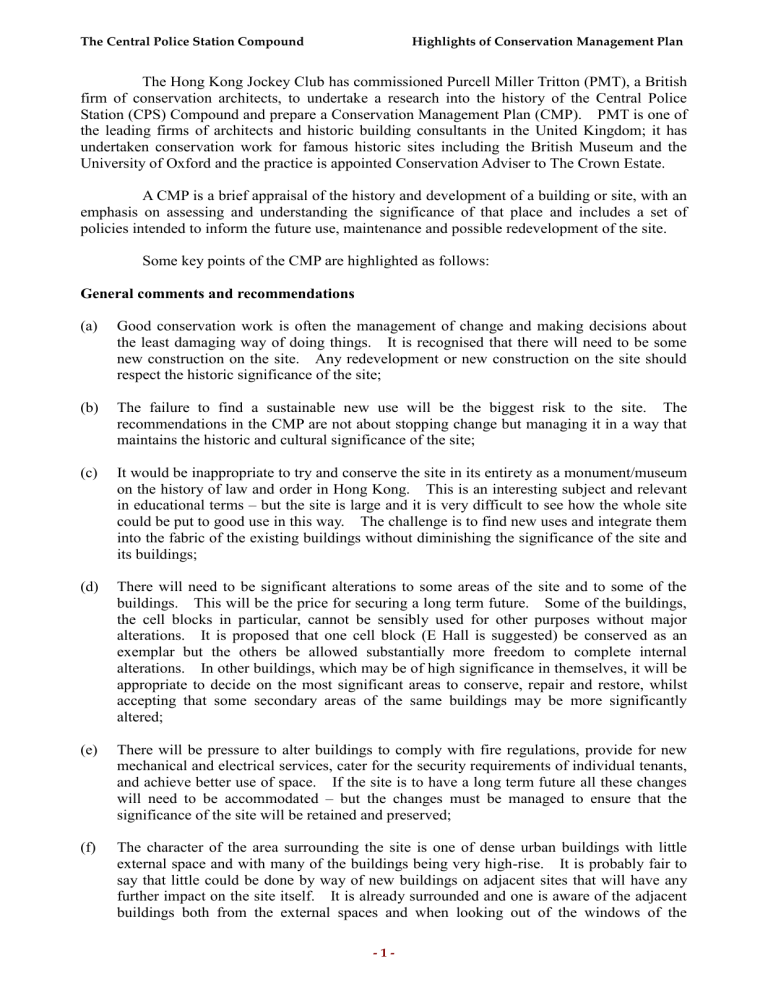
The Central Police Station Compound Highlights of Conservation Management Plan
The Hong Kong Jockey Club has commissioned Purcell Miller Tritton (PMT), a British firm of conservation architects, to undertake a research into the history of the Central Police
Station (CPS) Compound and prepare a Conservation Management Plan (CMP). PMT is one of the leading firms of architects and historic building consultants in the United Kingdom; it has undertaken conservation work for famous historic sites including the British Museum and the
University of Oxford and the practice is appointed Conservation Adviser to The Crown Estate.
A CMP is a brief appraisal of the history and development of a building or site, with an emphasis on assessing and understanding the significance of that place and includes a set of policies intended to inform the future use, maintenance and possible redevelopment of the site.
Some key points of the CMP are highlighted as follows:
General comments and recommendations
(a) Good conservation work is often the management of change and making decisions about the least damaging way of doing things. It is recognised that there will need to be some new construction on the site. Any redevelopment or new construction on the site should respect the historic significance of the site;
(b) The failure to find a sustainable new use will be the biggest risk to the site. The recommendations in the CMP are not about stopping change but managing it in a way that maintains the historic and cultural significance of the site;
(c) It would be inappropriate to try and conserve the site in its entirety as a monument/museum on the history of law and order in Hong Kong. This is an interesting subject and relevant in educational terms – but the site is large and it is very difficult to see how the whole site could be put to good use in this way. The challenge is to find new uses and integrate them into the fabric of the existing buildings without diminishing the significance of the site and its buildings;
(d) There will need to be significant alterations to some areas of the site and to some of the buildings. This will be the price for securing a long term future. Some of the buildings, the cell blocks in particular, cannot be sensibly used for other purposes without major alterations. It is proposed that one cell block (E Hall is suggested) be conserved as an exemplar but the others be allowed substantially more freedom to complete internal alterations. In other buildings, which may be of high significance in themselves, it will be appropriate to decide on the most significant areas to conserve, repair and restore, whilst accepting that some secondary areas of the same buildings may be more significantly altered;
(e) There will be pressure to alter buildings to comply with fire regulations, provide for new mechanical and electrical services, cater for the security requirements of individual tenants, and achieve better use of space. If the site is to have a long term future all these changes will need to be accommodated – but the changes must be managed to ensure that the significance of the site will be retained and preserved;
(f) The character of the area surrounding the site is one of dense urban buildings with little external space and with many of the buildings being very high-rise. It is probably fair to say that little could be done by way of new buildings on adjacent sites that will have any further impact on the site itself. It is already surrounded and one is aware of the adjacent buildings both from the external spaces and when looking out of the windows of the
- 1 -
The Central Police Station Compound Highlights of Conservation Management Plan buildings in the site. To this extent the site is no longer really vulnerable to adjacent redevelopments as ‘it has already happened’;
(g) It will be desirable to make new pedestrian routes across the site. Such routes should respect the existing building pattern, the division of the site into different compounds and, as far as it is possible, the historic entrances to the site;
(h) It will be necessary to make some new vehicle routes into the site for emergency vehicles and to facilitate servicing the site. Such routes should be as discreet as possible consistent with allowing the necessary access;
Comments on specific features
(i) The external granite walls around the site are one of the features that define the site and contribute to its significance. They are also a major townscape feature of the site. As far as possible the walls should be retained in their current form as a clear way of marking out the previous use of the site. However, respecting this should be balanced against achieving access to the site. This should also be compatible with new public and commercial uses;
(j) The Police Parade Ground should be preserved as an open space. It should remain free of unnecessary street furniture and should not have inappropriate activities (such as vending stalls, tables for alfresco dining, permanent stages, external screens, etc). Despite its historic use by the police this space should not be used for parking vehicles. The surfaces of the parade ground should be appropriate to its former use;
(k) The Prison Yard should be preserved as an open space. It should remain free of unnecessary street furniture and inappropriate activities. The essential character of the space as a simple and rather bleak area should be retained to maintain the feel and significance of the prison use;
(l) There is a smaller open space immediately south of the Magistracy notable for the granite entrance steps and the fine canopy over the French windows into the main court. This open space is significant and should not be built in but should be preserved as a courtyard free of unnecessary clutter;
(m) All the trees on the site are significant and should be protected from damage during any development works and should be retained. If these trees are lost they should be replaced with appropriate specimens in similar locations;
(n) The separation between the different compounds and the different levels of the site are all historically significant. These separating features should remain clear in any redevelopment of the site; and
(o) F Hall, whilst being of little architectural significance, is of some social significance as the entrance and exit to the Victoria Prison for prisoners and their visitors. For this reason it may be desirable to consider keeping the exterior of the building more or less in its present form with obvious modern additions removed.
Hong Kong Jockey Club
Development Bureau
July 2008
- 2 -




